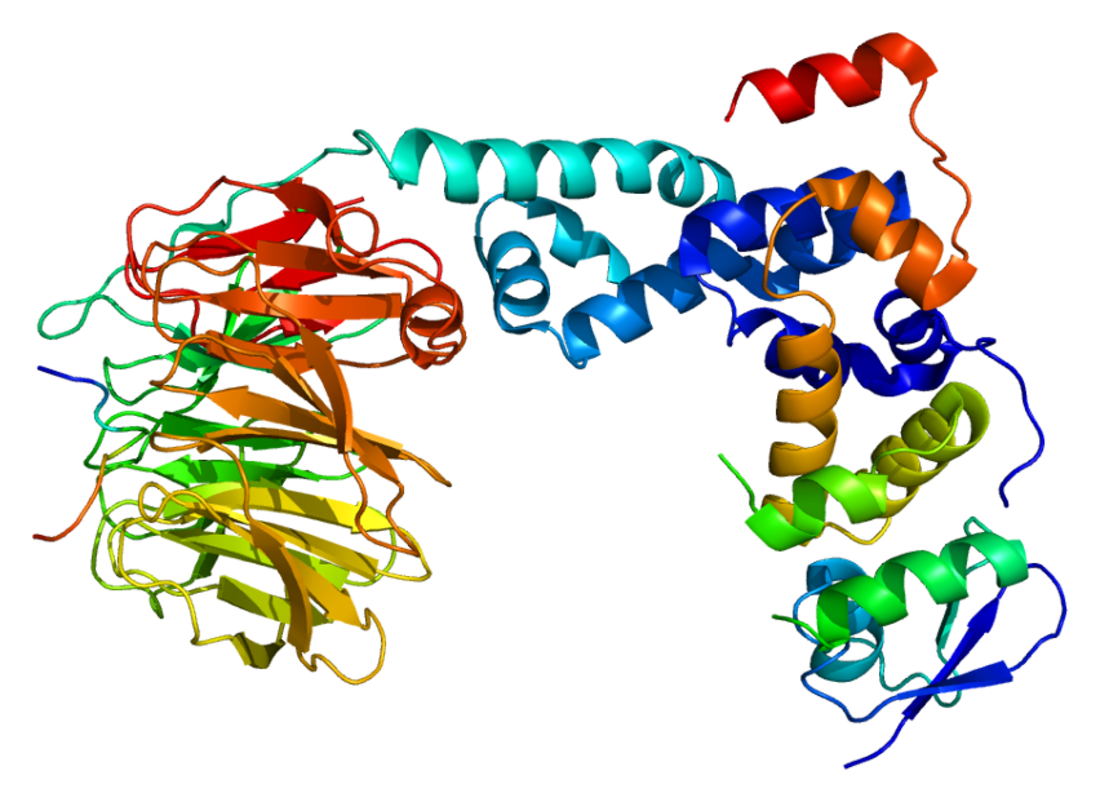BTRC (遺伝子)
ウィキペディアから
BTRC(β-transducin repeat containing)は、βTrCP1、FBXW1A(F-box/WD repeat-containing protein 1A)、FBXW1、pIκBα-E3 receptor subunitといった名称で知られるタンパク質をコードするヒトの遺伝子である[5][6]。
この遺伝子はF-boxタンパク質ファミリーのメンバーをコードする。F-boxタンパク質はF-boxと呼ばれる約40残基の構造モチーフによって特徴づけられる。F-boxタンパク質はSCF複合体と呼ばれるユビキチンリガーゼ複合体の4つのサブユニットのうちの1つを構成し、常にではないものの多くの場合、リン酸化依存的に基質を認識する。F-boxタンパク質は3つのクラスに分類される。
- Fbxw: WD40リピートを含む
- Fbxl: ロイシンリッチリピートを含む
- Fbxo: 他のタンパク質間相互作用モジュールを含む、または明確なモチーフが存在しない
この遺伝子にコードされるタンパク質はFbxwに属し、F-boxに加えて複数のWD40リピートを含む。このタンパク質はツメガエルのβTrCP、酵母のMet30、アカパンカビのScon2、ショウジョウバエのSlimbと相同である。哺乳類ではβTrCP1に加えて、βTrCP2またはFBXW11と呼ばれるパラログタンパク質が存在するが、これまでのところ両者の機能は冗長的であり区別できないようである。
発見
ヒトのβTrCP(βTrCP1とβTrCP2の双方を指す)は、HIV-1のVpuタンパク質が細胞のCD4をタンパク質分解装置と結び付けて除去する際に結合するユビキチンリガーゼとして同定された[7]。その後、βTrCPはさまざまな標的の分解を媒介することで複数の細胞過程を調節することが示された[8]。細胞周期の調節因子はβTrCPの基質の主要なグループを構成している。S期の間、βTrCPはホスファターゼCDC25Aの分解を促進することでCDK1を抑制しているが[9]、G2期にはキナーゼWEE1を分解の標的とすることでCDK1の活性化に寄与する[10]。有糸分裂の序盤には、βTrCPはAPC/Cユビキチンリガーゼ複合体の阻害因子であるEMI1の分解を媒介する[11][12]。APC/Cは中期から後期への移行(セキュリンの分解の誘導によって)と有糸分裂の終結(CDK1を活性化するサイクリンサブユニットの分解の駆動によって)を担う。さらに、βTrCPはRESTを標的とし、MAD2の転写抑制を解除する。MAD2はすべての染色分体が紡錘体の微小管に接着するまでAPC/Cを不活性化状態に維持する、紡錘体チェックポイントの必須の構成要素であり、βTrCPはこのようにAPC/Cを制御する[13]。
機能
βTrCPは細胞周期チェックポイントの調節に重要な役割を果たす。βTrCPは遺伝毒性ストレスに応答して、Chk1とともにCDC25Aの分解を媒介することでCDK1活性の低下に寄与し[9][14]、DNA修復が完了するまで細胞周期の進行を防ぐ。DNA複製やDNA損傷からの回復の間、βTrCPはPLK1依存的にクラスピンを標的とする[15][16][17]。
βTrCPはタンパク質の翻訳、細胞成長や生存過程においてもにおける重要な因子であることが判明している。分裂促進因子に対する応答として、翻訳開始因子eIF4Aの阻害因子であるPDCD4はβTrCPとS6K1依存的に迅速に分解され、効率的な翻訳と細胞成長が行われる[18]。タンパク質の翻訳に関与する他の標的としてはeEF2Kがある。eEF2Kは翻訳伸長因子eEF2をリン酸化してリボソームへの親和性を低下させる[19]。また、βTrCPはmTORやCK1αと協働してmTORの阻害因子であるDEPTORの分解を誘導し、mTORの完全な活性化を促進する自己増幅ループを作り出す[20][21][22]。同時に、βTrCPはアポトーシス促進タンパク質BimELの分解を媒介し、細胞生存を促進する[23]。
βTrCPはリン酸化されたIκBαとβ-カテニンの分解モチーフと結合し、おそらくNF-κBとWnt経路を調節することで複数の転写プログラムで機能している[24][25]。βTrCPは中心小体のdisengagement(解離)とlicensing(複製ライセンス化)を調節することが示されている。βTrCPは前中期にintercentrosomal linker protein(中心体間リンカータンパク質)CEP68を標的とし、中心小体のdisengagementとその後のseparation(分離)に寄与する[26]。
相互作用
βTrCPは次に挙げる因子と相互作用することが示されている。
臨床的意義
βTrCPは一部の組織ではがんタンパク質としてふるまう。βTrCPの発現レベルの上昇は、大腸がん[39]、膵臓がん[40]、肝芽腫[41]、そして乳がん[42]でみられる。
出典
関連文献
外部リンク
Wikiwand - on
Seamless Wikipedia browsing. On steroids.





